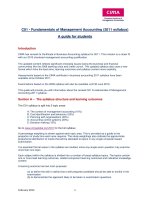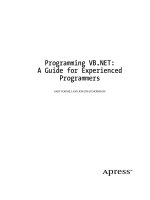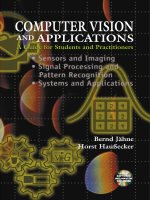computer vision and applications - a guide for students and practitioners (ap,2000)(t)(702s)
Bạn đang xem bản rút gọn của tài liệu. Xem và tải ngay bản đầy đủ của tài liệu tại đây (22.67 MB, 702 trang )
Computer Vision
and Applications
A Guide for Students and Practitioners
LIMITED WARRANTY AND DISCLAIMER OF LIABILITY
ACADEMIC PRESS ("AP") AND ANYONE ELSE WHO HAS BEEN INVOLVED IN THE CREATION
OR PRODUCTION OF THE ACCOMPANYING CODE ("THE PRODUCT") CANNOT AND DO
NOT WARRANT THE PERFORMANCE OR RESULTS THAT MAY BE OBTAINED BY USING THE
PRODUCT. THE PRODUCT IS SOLD "AS IS" WITHOUT WARRANTY OF MERCHANTABILITY
OR FITNESS FOR ANY PARTICULAR PURPOSE. AP WARRANTS ONLY THAT THE MAGNETIC
CD-ROM(S) ON WHICH THE CODE IS RECORDED IS FREE FROM DEFECTS IN MATERIAL
AND FAULTY WORKMANSHIP UNDER THE NORMAL USE AND SERVICE FOR A PERIOD OF
NINETY (90) DAYS FROM THE DATE THE PRODUCT IS DELIVERED. THE PURCHASER’S SOLE
AND EXCLUSIVE REMEDY IN THE VENT OF A DEFECT IS EXPRESSLY LIMITED TO EITHER
REPLACEMENT OF THE CD-ROM(S) OR REFUND OF THE PURCHASE PRICE, AT AP’S SOLE
DISCRETION.
IN NO EVENT, WHETHER AS A RESULT OF BREACH OF CONTRACT, WARRANTY, OR TORT
(INCLUDING NEGLIGENCE), WILL AP OR ANYONE WHO HAS BEEN INVOLVED IN THE CRE-
ATION OR PRODUCTION OF THE PRODUCT BE LIABLE TO PURCHASER FOR ANY DAM-
AGES, INCLUDING ANY LOST PROFITS, LOST SAVINGS OR OTHER INCIDENTAL OR CON-
SEQUENTIAL DAMAGES ARISING OUT OF THE USE OR INABILITY TO USE THE PRODUCT
OR ANY MODIFICATIONS THEREOF, OR DUE TO THE CONTENTS OF THE CODE, EVEN IF
AP HAS BEEN ADVISED ON THE POSSIBILITY OF SUCH DAMAGES, OR FOR ANY CLAIM BY
ANY OTHER PARTY.
ANY REQUEST FOR REPLACEMENT OF A DEFECTIVE CD-ROM MUST BE POSTAGE PREPAID
AND MUST BE ACCOMPANIED BY THE ORIGINAL DEFECTIVE CD-ROM, YOUR MAILING AD-
DRESS AND TELEPHONE NUMBER, AND PROOF OF DATE OF PURCHASE AND PURCHASE
PRICE. SEND SUCH REQUESTS, STATING THE NATURE OF THE PROBLEM, TO ACADEMIC
PRESS CUSTOMER SERVICE, 6277 SEA HARBOR DRIVE, ORLANDO, FL 32887, 1-800-321-
5068. AP SHALL HAVE NO OBLIGATION TO REFUND THE PURCHASE PRICE OR TO RE-
PLACE A CD-ROM BASED ON CLAIMS OF DEFECTS IN THE NATURE OR OPERATION OF
THE PRODUCT.
SOME STATES DO NOT ALLOW LIMITATION ON HOW LONG AN IMPLIED WARRANTY
LASTS, NOR EXCLUSIONS OR LIMITATIONS OF INCIDENTAL OR CONSEQUENTIAL DAM-
AGE, SO THE ABOVE LIMITATIONS AND EXCLUSIONS MAY NOT APPLY TO YOU. THIS WAR-
RANTY GIVES YOU SPECIFIC LEGAL RIGHTS, AND YOU MAY ALSO HAVE OTHER RIGHTS
WHICH VARY FROM JURISDICTION TO JURISDICTION.
THE RE-EXPORT OF UNITED STATES ORIGINAL SOFTWARE IS SUBJECT TO THE UNITED
STATES LAWS UNDER THE EXPORT ADMINISTRATION ACT OF 1969 AS AMENDED. ANY
FURTHER SALE OF THE PRODUCT SHALL BE IN COMPLIANCE WITH THE UNITED STATES
DEPARTMENT OF COMMERCE ADMINISTRATION REGULATIONS. COMPLIANCE WITH SUCH
REGULATIONS IS YOUR RESPONSIBILITY AND NOT THE RESPONSIBILITY OF AP.
Computer Vision
and Applications
A Guide for Students and Practitioners
Editors
Bernd Jähne
Interdisciplinary Center for Scientific Computing
University of Heidelberg, Heidelberg, Germany
and
Scripps Institution of Oceanography
University of California, San Diego
Horst Haußecker
Xerox Palo Alto Research Center
San Diego San Francisco New York Boston
London Sydney Tokyo
This book is printed on acid-free paper.
Copyright © 2000 by Academic Press.
All rights reserved.
No part of this publication may be reproduced or transmitted in any form or
by any means, electronic or mechanical, including photocopy, recording, or
any information storage and retrieval system, without permission in writing
from the publisher.
Requests for permission to make copies of any part of the work should be
mailed to: Permissions Department, Harcourt, Inc., 6277 Sea Harbor Drive,
Orlando, Florida, 32887-6777.
ACADEMIC PRESS
A Harcourt Science and Technology Company
525 B Street, Suite 1900, San Diego, CA 92101-4495, USA
Academic Press
24-28 Oval Road, London NW1 7DX, UK
/>Library of Congress Catalog Number: 99-68829
International Standard Book Number: 0–12–379777-2
Printed in the United States of America
0001020304EB987654321
Contents
Preface xi
Contributors xv
1 Introduction 1
B. Jähne
1.1 Components of a vision system 1
1.2 Imaging systems 2
1.3 Signal processing for computer vision 3
1.4 Pattern recognition for computer vision 4
1.5 Performance evaluation of algorithms 5
1.6 Classes of tasks 6
1.7 References 8
I Sensors and Imaging
2 Radiation and Illumination 11
H. Haußecker
2.1 Introduction 12
2.2 Fundamentals of electromagnetic radiation 13
2.3 Radiometric quantities 17
2.4 Fundamental concepts of photometry 27
2.5 Interaction of radiation with matter 31
2.6 Illumination techniques 46
2.7 References 51
3 Imaging Optics 53
P. Geißler
3.1 Introduction 54
3.2 Basic concepts of geometric optics 54
3.3 Lenses 56
3.4 Optical properties of glasses 66
3.5 Aberrations 67
3.6 Optical image formation 75
3.7 Wave and Fourier optics 80
3.8 References 84
v
vi Contents
4 Radiometry of Imaging 85
H. Haußecker
4.1 Introduction 85
4.2 Observing surfaces 86
4.3 Propagating radiance 88
4.4 Radiance of imaging 91
4.5 Detecting radiance 94
4.6 Concluding summary 108
4.7 References 109
5 Solid-State Image Sensing 111
P. Seitz
5.1 Introduction 112
5.2 Fundamentals of solid-state photosensing 113
5.3 Photocurrent processing 120
5.4 Transportation of photosignals 127
5.5 Electronic signal detection 130
5.6 Architectures of image sensors 134
5.7 Color vision and color imaging 139
5.8 Practical limitations of semiconductor photosensors 146
5.9 Conclusions 148
5.10 References 149
6 Geometric Calibration of Digital Imaging Systems 153
R. Godding
6.1 Introduction 153
6.2 Calibration terminology 154
6.3 Parameters influencing geometrical performance 155
6.4 Optical systems model of image formation 157
6.5 Camera models 158
6.6 Calibration and orientation techniques 163
6.7 Photogrammetric applications 170
6.8 Summary 173
6.9 References 173
7 Three-Dimensional Imaging Techniques 177
R. Schwarte, G. Häusler, R. W. Malz
7.1 Introduction 178
7.2 Characteristics of 3-D sensors 179
7.3 Triangulation 182
7.4 Time-of-flight (TOF) of modulated light 196
7.5 Optical Interferometry (OF) 199
7.6 Conclusion 205
7.7 References 205
Contents vii
II Signal Processing and Pattern Recognition
8 Representation of Multidimensional Signals 211
B. Jähne
8.1 Introduction 212
8.2 Continuous signals 212
8.3 Discrete signals 215
8.4 Relation between continuous and discrete signals 224
8.5 Vector spaces and unitary transforms 232
8.6 Continuous Fourier transform (FT) 237
8.7 The discrete Fourier transform (DFT) 246
8.8 Scale of signals 252
8.9 Scale space and diffusion 260
8.10 Multigrid representations 267
8.11 References 271
9 Neighborhood Operators 273
B. Jähne
9.1 Basics 274
9.2 Linear shift-invariant filters 278
9.3 Recursive filters 285
9.4 Classes of nonlinear filters 292
9.5 Local averaging 296
9.6 Interpolation 311
9.7 Edge detection 325
9.8 Tensor representation of simple neighborhoods 335
9.9 References 344
10 Motion 347
H. Haußecker and H. Spies
10.1 Introduction 347
10.2 Basics: flow and correspondence 349
10.3 Optical flow-based motion estimation 358
10.4 Quadrature filter techniques 372
10.5 Correlation and matching 379
10.6 Modeling of flow fields 382
10.7 References 392
11 Three-Dimensional Imaging Algorithms 397
P. Geißler, T. Dierig, H. A. Mallot
11.1 Introduction 397
11.2 Stereopsis 398
11.3 Depth-from-focus 414
11.4 References 435
12 Design of Nonlinear Diffusion Filters 439
J. Weickert
12.1 Introduction 439
12.2 Filter design 440
12.3 Parameter selection 448
12.4 Extensions 451
12.5 Relations to variational image restoration 452
viii Contents
12.6 Summary 454
12.7 References 454
13 Variational Adaptive Smoothing and Segmentation 459
C. Schnörr
13.1 Introduction 459
13.2 Processing of two- and three-dimensional images 463
13.3 Processing of vector-valued images 474
13.4 Processing of image sequences 476
13.5 References 480
14 Morphological Operators 483
P. Soille
14.1 Introduction 483
14.2 Preliminaries 484
14.3 Basic morphological operators 489
14.4 Advanced morphological operators 495
14.5 References 515
15 Probabilistic Modeling in Computer Vision 517
J. Hornegger, D. Paulus, and H. Niemann
15.1 Introduction 517
15.2 Why probabilistic models? 518
15.3 Object recognition as probabilistic modeling 519
15.4 Model densities 524
15.5 Practical issues 536
15.6 Summary, conclusions, and discussion 538
15.7 References 539
16 Fuzzy Image Processing 541
H. Haußecker and H. R. Tizhoosh
16.1 Introduction 541
16.2 Fuzzy image understanding 548
16.3 Fuzzy image processing systems 553
16.4 Theoretical components of fuzzy image processing 556
16.5 Selected application examples 564
16.6 Conclusions 570
16.7 References 571
17 Neural Net Computing for Image Processing 577
A. Meyer-Bäse
17.1 Introduction 577
17.2 Multilayer perceptron (MLP) 579
17.3 Self-organizing neural networks 585
17.4 Radial-basis neural networks (RBNN) 590
17.5 Transformation radial-basis networks (TRBNN) 593
17.6 Hopfield neural networks 596
17.7 Application examples of neural networks 601
17.8 Concluding remarks 604
17.9 References 605
Contents ix
III Application Gallery
A Application Gallery 609
A1 Object Recognition with Intelligent Cameras 610
T. Wagner, and P. Plankensteiner
A2 3-D Image Metrology of Wing Roots 612
H. Beyer
A3 Quality Control in a Shipyard 614
H G. Maas
A4 Topographical Maps of Microstructures 616
Torsten Scheuermann, Georg Wiora and Matthias Graf
A5 Fast 3-D Full Body Scanning for Humans and Other Objects . 618
N. Stein and B. Minge
A6 Reverse Engineering Using Optical Range Sensors 620
S. Karbacher and G. Häusler
A7 3-D Surface Reconstruction from Image Sequences 622
R. Koch, M. Pollefeys and L. Von Gool
A8 Motion Tracking 624
R. Frischholz
A9 Tracking “Fuzzy” Storms in Doppler Radar Images 626
J.L. Barron, R.E. Mercer, D. Cheng, and P. Joe
A10 3-D Model-Driven Person Detection 628
Ch. Ridder, O. Munkelt and D. Hansel
A11 Knowledge-Based Image Retrieval 630
Th. Hermes and O. Herzog
A12 Monitoring Living Biomass with in situ Microscopy 632
P. Geißler and T. Scholz
A13 Analyzing Size Spectra of Oceanic Air Bubbles 634
P. Geißler and B. Jähne
A14 Thermography to Measure Water Relations of Plant Leaves 636
B. Kümmerlen, S. Dauwe, D. Schmundt and U. Schurr
A15 Small-Scale Air-Sea Interaction with Thermography 638
U. Schimpf, H. Haußecker and B. Jähne
A16 Optical Leaf Growth Analysis 640
D. Schmundt and U. Schurr
A17 Analysis of Motility Assay Data 642
D. Uttenweiler and R. H. A. Fink
A18 Fluorescence Imaging of Air-Water Gas Exchange 644
S. Eichkorn, T. Münsterer, U. Lode and B. Jähne
A19 Particle-Tracking Velocimetry 646
D. Engelmann, M. Stöhr, C. Garbe, and F. Hering
A20 Analyzing Particle Movements at Soil Interfaces 648
H. Spies, H. Gröning, and H. Haußecker
A21 3-D Velocity Fields from Flow Tomography Data 650
H G. Maas
A22 Cloud Classification Analyzing Image Sequences 652
M. Wenig, C. Leue
x Contents
A23 NO
X
Emissions Retrieved from Satellite Images 654
C. Leue, M. Wenig and U. Platt
A24 Multicolor Classification of Astronomical Objects 656
C. Wolf, K. Meisenheimer, and H J. Roeser
A25 Model-Based Fluorescence Imaging 658
D. Uttenweiler and R. H. A. Fink
A26 Analyzing the 3-D Genome Topology 660
H. Bornfleth, P. Edelmann, and C. Cremer
A27 References 662
Index 667
Preface
What this book is about
This book offers a fresh approach to computer vision. The whole vision
process from image formation to measuring, recognition, or reacting
is regarded as an integral process. Computer vision is understood as
the host of techniques to acquire, process, analyze, and understand
complex higher-dimensional data from our environment for scientific
and technical exploration.
In this sense this book takes into account the interdisciplinary na-
ture of computer vision with its links to virtually all natural sciences
and attempts to bridge two important gaps. The first is between mod-
ern physical sciences and the many novel techniques to acquire images.
The second is between basic research and applications. When a reader
with a background in one of the fields related to computer vision feels
he has learned something from one of the many other facets of com-
puter vision, the book will have fulfilled its purpose.
This book comprises three parts. The first part, Sensors and Imag-
ing, covers image formation and acquisition. The second part, Signal
Processing and Pattern Recognition, focuses on processing of the spatial
and spatiotemporal signals acquired by imaging sensors. The third part
consists of an Application Gallery, which shows in a concise overview
a wide range of application examples from both industry and science.
This part illustrates how computer vision is integrated into a variety of
systems and applications.
Computer Vision and Applications was designed as a concise edition
of the three-volume handbook:
Handbook of Computer Vision and Applications
edited by B. Jähne, H. Haußecker, and P. Geißler
Vol 1: Sensors and Imaging;
Vol 2: Signal Processing and Pattern Recognition;
Vol 3: Systems and Applications
Academic Press, 1999
xi
xii Preface
It condenses the content of the handbook into one single volume
and contains a selection of shortened versions of the most important
contributions of the full edition. Although it cannot detail every single
technique, this book still covers the entire spectrum of computer vision
ranging from the imaging process to high-end algorithms and applica-
tions. Students in particular can benefit from the concise overview of
the field of computer vision. It is perfectly suited for sequential reading
into the subject and it is complemented by the more detailed Handbook
of Computer Vision and Applications. The reader will find references
to the full edition of the handbook whenever applicable. In order to
simplify notation we refer to supplementary information in the hand-
book by the abbreviations [CVA1, Chapter N], [CVA2, Chapter N], and
[CVA3, Chapter N] for the N
th
chapter in the first, second and third
volume, respectively. Similarly, direct references to individual sections
in the handbook are given by [CVA1, Section N], [CVA2, Section N], and
[CVA3, Section N] for section number N.
Prerequisites
It is assumed that the reader is familiar with elementary mathematical
concepts commonly used in computer vision and in many other areas
of natural sciences and technical disciplines. This includes the basics
of set theory, matrix algebra, differential and integral equations, com-
plex numbers, Fourier transform, probability, random variables, and
graph theory. Wherever possible, mathematical topics are described
intuitively. In this respect it is very helpful that complex mathematical
relations can often be visualized intuitively by images. For a more for-
mal treatment of the corresponding subject including proofs, suitable
references are given.
How to use this book
The book has been designed to cover the different needs of its reader-
ship. First, it is suitable for sequential reading. In this way the reader
gets an up-to-date account of the state of computer vision. It is pre-
sented in a way that makes it accessible for readers with different back-
grounds. Second, the reader can look up specific topics of interest.
The individual chapters are written in a self-consistent way with ex-
tensive cross-referencing to other chapters of the book and external
references. Additionally, a detailed glossary allows to easily access the
most important topics independently of individual chapters. The CD
that accompanies this book contains the complete text of the book in
the Adobe Acrobat portable document file format (PDF). This format
can be read on all major platforms. Free Acrobat™ Reader version 4.0
Preface xiii
for all major computing platforms is included on the CDs. The texts are
hyperlinked in multiple ways. Thus the reader can collect the informa-
tion of interest with ease. Third, the reader can delve more deeply into
a subject with the material on the CDs. They contain additional refer-
ence material, interactive software components, code examples, image
material, and references to sources on the Internet. For more details
see the readme file on the CDs.
Acknowledgments
Writing a book on computer vision with this breadth of topics is a major
undertaking that can succeed only in a coordinated effort that involves
many co-workers. Thus the editors would like to thank first all contrib-
utors who were willing to participate in this effort. Their cooperation
with the constrained time schedule made it possible that this concise
edition of the Handbook of Computer Vision and Applications could be
published in such a short period following the release of the handbook
in May 1999. The editors are deeply grateful for the dedicated and pro-
fessional work of the staff at AEON Verlag & Studio who did most of the
editorial work. We also express our sincere thanks to Academic Press
for the opportunity to write this book and for all professional advice.
Last but not least, we encourage the reader to send us any hints
on errors, omissions, typing errors, or any other shortcomings of the
book. Actual information about the book can be found at the editors
homepage .
Heidelberg, Germany, and Palo Alto, California
Bernd Jähne, Horst Haußecker
xiv
Contributors
Prof. Dr. John L. Barron
Dept. of Computer Science, Middlesex College
The University of Western Ontario, London, Ontario, N6A 5B7, Canada
Horst A. Beyer
Imetric SA, Technopole, CH-2900 Porrentry, Switzerland
,
Dr. Harald Bornfleth
Institut für Angewandte Physik, Universität Heidelberg
Albert-Überle-Str. 3-5, D-69120 Heidelberg, Germany
Harald.Bornfl
/>David Cheng
Dept. of Computer Science, Middlesex College
The University of Western Ontario, London, Ontario, N6A 5B7, Canada
Prof. Dr. Christoph Cremer
Institut für Angewandte Physik, Universität Heidelberg
Albert-Überle-Str. 3-5, D-69120 Heidelberg, Germany
/>Tobias Dierig
Forschungsgruppe Bildverarbeitung, IWR, Universität Heidelberg
Im Neuenheimer Feld 368, D-69120 Heidelberg
Tobias
Stefan Dauwe
Botanisches Institut, Universität Heidelberg
Im Neuenheimer Feld 360, D-69120 Heidelberg, Germany
Peter U. Edelmann
Institut für Angewandte Physik, Universität Heidelberg
Albert-Überle-Str. 3-5, D-69120 Heidelberg, Germany
/>Sven Eichkorn
Max-Planck-Institut für Kernphysik, Abteilung Atmosphärenphysik
xv
xvi Contributors
Saupfercheckweg 1, D-69117 Heidelberg, Germany
Dirk Engelmann
Forschungsgruppe Bildverarbeitung, IWR, Universität Heidelberg
Im Neuenheimer Feld 368, D-69120 Heidelberg
/>Prof. Dr. Rainer H. A. Fink
II. Physiologisches Institut, Universität Heidelberg
Im Neuenheimer Feld 326, D-69120 Heidelberg, Germany
fi
Dr. Robert Frischholz
DCS AG, Wetterkreuz 19a, D-91058 Erlangen, Germany
,
Christoph Garbe
Forschungsgruppe Bildverarbeitung, IWR, Universität Heidelberg
Im Neuenheimer Feld 368, D-69120 Heidelberg
Dr. Peter Geißler
ARRI, Abteilung TFE, Türkenstraße 95, D-80799 München
Dipl Ing. Robert Godding
AICON GmbH, Celler Straße 32, D-38114 Braunschweig, Germany
,
Matthias Graf
Institut für Kunststoffprüfung und Kunststoffkunde
(IKP), Pfaffenwaldring 32, D-70569 Stuttgart, Germany
,
Hermann Gröning
Forschungsgruppe Bildverarbeitung, IWR, Universität Heidelberg
Im Neuenheimer Feld 360, D-69120 Heidelberg, Germany
David Hansel
FORWISS, Bayerisches Forschungszentrum für Wissensbasierte Systeme
Forschungsgruppe Kognitive Systeme, Orleansstr. 34, 81667 München
/>Prof. Dr. Gerd Häusler
Chair for Optics, Universität Erlangen-Nürnberg
Staudtstraße 7/B2, D-91056 Erlangen, Germany
/>Contributors xvii
Dr. Horst Haußecker
Xerox Palo Alto Research Center (PARC)
3333 Coyote Hill Road, Palo Alto, CA 94304
,
Dr. Frank Hering
SAP AG, Neurottstraße 16, D-69190 Walldorf, Germany
Dipl Inform. Thorsten Hermes
Center for Computing Technology, Image Processing Department
University of Bremen, P.O. Box 33 0440, D-28334 Bremen, Germany
, />Prof. Dr. Otthein Herzog
Center for Computing Technology, Image Processing Department
University of Bremen, P.O. Box 33 0440, D-28334 Bremen, Germany
, />Dr. Joachim Hornegger
Lehrstuhl für Mustererkennung (Informatik 5)
Universität Erlangen-Nürnberg, Martensstraße 3, 91058 Erlangen, Germany
Prof. Dr. Bernd Jähne
Forschungsgruppe Bildverarbeitung, IWR, Universität Heidelberg
Im Neuenheimer Feld 368, D-69120 Heidelberg
Dr. Paul Joe
King City Radar Station, Atmospheric Environmental Services
4905 Dufferin St., Toronto, Ontario M3H 5T4, Canada
Stefan Karbacher
Chair for Optics, Universität Erlangen-Nürnberg
Staudtstraße 7/B2, D-91056 Erlangen, Germany
,
Prof. Dr Ing. Reinhard Koch
Institut für Informatik und Praktische Mathematik
Christian-Albrechts-Universität Kiel, Olshausenstr. 40, D 24098 Kiel, Germany
Bernd Kümmerlen
Botanisches Institut, Universität Heidelberg
Im Neuenheimer Feld 360, D-69120 Heidelberg, Germany
Dr. Carsten Leue
Institut für Umweltphysik, Universität Heidelberg
Im Neuenheimer Feld 229, D-69120 Heidelberg, Germany
Ulrike Lode
Institut für Umweltphysik, Universität Heidelberg
xviii Contributors
Im Neuenheimer Feld 229, D-69120 Heidelberg, Germany
Prof. Dr Ing. Hans-Gerd Maas
Institute for Photogrammetry and Remote Sensing
Technical University Dresden, D-01062 Dresden, Germany
Prof. Dr Ing. Reinhard Malz
Fachhochschule Esslingen, Fachbereich Informationstechnik
Flandernstr. 101, D-73732 Esslingen
Dr. Hanspeter A. Mallot
Max-Planck-Institut für biologische Kybernetik
Spemannstr. 38, 72076 Tübingen, Germany
/>Prof. Robert E. Mercer
Dept. of Computer Science, Middlesex College
The University of Western Ontario, London, Ontario, N6A 5B7, Canada
Dr. Anke Meyer-Bäse
Dept. of Electrical Engineering and Computer Science
University of Florida, 454 New Engineering Building 33, Center Drive
PO Box 116130, Gainesville, FL 32611-6130, U.S.
fl.edu
Bernhard Minge
VITRONIC Dr Ing. Stein Bildverarbeitungssysteme GmbH
Hasengartenstrasse 14a, D-65189 Wiesbaden, Germany
,
Dr. Olaf Munkelt
FORWISS, Bayerisches Forschungszentrum für Wissensbasierte Systeme
Forschungsgruppe Kognitive Systeme, Orleansstr. 34, 81667 München
, />Dr. Thomas Münsterer
VITRONIC Dr Ing. Stein Bildverarbeitungssysteme GmbH
Hasengartenstr. 14a, D-65189 Wiesbaden, Germany
Phone: +49-611-7152-38,
Prof. Dr Ing. Heinrich Niemann
Lehrstuhl für Mustererkennung (Informatik 5)
Universität Erlangen-Nürnberg, Martensstraße 3, 91058 Erlangen, Germany
Dr. Dietrich Paulus
Lehrstuhl für Mustererkennung (Informatik 5)
Universität Erlangen-Nürnberg, Martensstraße 3, 91058 Erlangen, Germany
Contributors xix
Dipl Math. Peter Plankensteiner
Intego Plankensteiner Wagner Gbr
Am Weichselgarten 7, D-91058 Erlangen
Prof. Dr. Ulrich Platt
Institut für Umweltphysik, Universität Heidelberg
Im Neuenheimer Feld 229, D-69120 Heidelberg, Germany
/>Dr. Marc Pollefeys
Katholieke Universiteit Leuven, ESAT-PSI/VISICS
Kardinaal Mercierlaan 94, B-3001 Heverlee, Belgium
/>Christof Ridder
FORWISS, Bayerisches Forschungszentrum für Wissensbasierte Systeme
Forschungsgruppe Kognitive Systeme, Orleansstr. 34, 81667 München
, />Dr. Torsten Scheuermann
Fraunhofer USA, Headquarters
24 Frank Lloyd Wright Drive, Ann Arbor, MI 48106-0335, U.S.
,
Dr. Uwe Schimpf
Forschungsgruppe Bildverarbeitung, IWR, Universität Heidelberg
Im Neuenheimer Feld 360, D-69120 Heidelberg, Germany
Dr. Dominik Schmundt
Forschungsgruppe Bildverarbeitung, IWR, Universität Heidelberg
Im Neuenheimer Feld 360, D-69120 Heidelberg, Germany
/>Prof. Dr. Christoph Schnörr
Dept. of Math. & Computer Science, University of Mannheim
D-68131 Mannheim, Germany
,
Dr. Thomas Scholz
SAP AG, Neurottstraße 16, D-69190 Walldorf, Germany
Dr. Ulrich Schurr
Botanisches Institut, Universität Heidelberg
Im Neuenheimer Feld 360, D-69120 Heidelberg, Germany
/>xx Contributors
Prof. Dr. Rudolf Schwarte
Institut für Nachrichtenverarbeitung (INV)
Universität-GH Siegen, Hölderlinstr. 3, D-57068 Siegen, Germany
/>Prof. Dr. Peter Seitz
Centre Suisse d’Electronique et de Microtechnique SA (CSEM)
Badenerstrasse 569, CH-8048 Zurich, Switzerland
, />Prof. Dr. Pierre Soille
Silsoe Research Institute, Wrest Park
Silsoe, Bedfordshire, MK45 4HS, United Kingdom
, />Hagen Spies
Forschungsgruppe Bildverarbeitung, IWR, Universität Heidelberg
Im Neuenheimer Feld 368, D-69120 Heidelberg
Dr Ing. Norbert Stein
VITRONIC Dr Ing. Stein Bildverarbeitungssysteme GmbH
Hasengartenstrasse 14a, D-65189 Wiesbaden, Germany
,
Michael Stöhr
Forschungsgruppe Bildverarbeitung, IWR, Universität Heidelberg
Im Neuenheimer Feld 368, D-69120 Heidelberg
Hamid R. Tizhoosh
Universität Magdeburg (IPE)
P.O. Box 4120, D-39016 Magdeburg, Germany
/>Dr. Dietmar Uttenweiler
II. Physiologisches Institut, Universität Heidelberg
Im Neuenheimer Feld 326, D-69120 Heidelberg, Germany
Prof. Dr. Luc Van Gool
Katholieke Universiteit Leuven, ESAT-PSI/VISICS
Kardinaal Mercierlaan 94, B-3001 Heverlee, Belgium
/>Dr. Thomas Wagner
Intego Plankensteiner Wagner Gbr
Am Weichselgarten 7, D-91058 Erlangen
Contributors xxi
Dr. Joachim Weickert
Dept. of Math. & Computer Science, University of Mannheim
D-68131 Mannheim, Germany
Mark O. Wenig
Institut für Umweltphysik, Universität Heidelberg
Im Neuenheimer Feld 229, D-69120 Heidelberg, Germany
/>Georg Wiora
DaimlerChrysler AG, Research and Development
Wilhelm-Runge-Str. 11, D-89081 Ulm, Germany
Dr. Christian Wolf
Max-Planck Institut für Astronomie
Königstuhl 17, D-69117 Heidelberg
xxii
1 Introduction
Bernd Jähne
Interdisziplinäres Zentrum für Wissenschaftliches Rechnen (IWR)
Universität Heidelberg, Germany
1.1 Components of a vision system 1
1.2 Imaging systems 2
1.3 Signal processing for computer vision 3
1.4 Pattern recognition for computer vision 4
1.5 Performance evaluation of algorithms 5
1.6 Classes of tasks 6
1.7 References 8
1.1 Components of a vision system
Computer vision is a complex subject. As such it is helpful to divide
it into its various components or function modules. On this level, it
is also much easier to compare a technical system with a biological
system. In this sense, the basic common functionality of biological and
machine vision includes the following components (see also Table 1.1):
Radiation source. If no radiation is emitted from the scene or the ob-
ject of interest, nothing can be observed or processed. Thus appro-
priate illumination is necessary for objects that are themselves not
radiant.
Camera. The “camera” collects the radiation received from the object
in such a way that the radiation’s origins can be pinpointed. In
the simplest case this is just an optical lens. But it could also be a
completely different system, for example, an imaging optical spec-
trometer, an x-ray tomograph, or a microwave dish.
Sensor. The sensor converts the received radiative flux density into a
suitable signal for further processing. For an imaging system nor-
mally a 2-D array of sensors is required to capture the spatial dis-
tribution of the radiation. With an appropriate scanning system in
some cases a single sensor or a row of sensors could be sufficient.
1
Computer Vision and Applications Copyright © 2000 by Academic Press
All rights of reproduction in any form reserved.
ISBN 0–12–379777-2/$30.00
2 1 Introduction
Table 1.1: Function modules of human and machine vision
Task Human vision Machine vision
Visualization Passive, mainly by re-
flection of light from
opaque surfaces
Passive and active (controlled il-
lumination) using electromagnetic,
particulate, and acoustic radiation
Image
formation
Refractive optical sys-
tem
Various systems
Control of
irradiance
Muscle-controlled pupil Motorized apertures, filter wheels,
tunable filters
Focusing Muscle-controlled
change of focal length
Autofocus systems based on vari-
ous principles of distance measure-
ments
Irradiance
resolution
Logarithmic sensitivity Linear sensitivity, quantization be-
tween 8- and 16-bits; logarithmic
sensitivity
Tracking Highly mobile eyeball Scanner and robot-mounted cam-
eras
Processing
and analysis
Hierarchically
organized massively
parallel processing
Serial processing still dominant;
parallel processing not in general
use
Processing unit. It processes the incoming, generally higher-dimen-
sional data, extracting suitable features that can be used to measure
object properties and categorize them into classes. Another impor-
tant component is a memory system to collect and store knowl-
edge about the scene, including mechanisms to delete unimportant
things.
Actors. Actors react to the result of the visual observation. They be-
come an integral part of the vision system when the vision system
is actively responding to the observation by, for example, tracking
an object of interest or by using a vision-guided navigation (active
vision, perception action cycle).
1.2 Imaging systems
Imaging systems cover all processes involved in the formation of an
image from objects and the sensors that convert radiation into elec-
tric signals, and further into digital signals that can be processed by
a computer. Generally the goal is to attain a signal from an object in
such a form that we know where it is (geometry), and what it is or what
properties it has.









